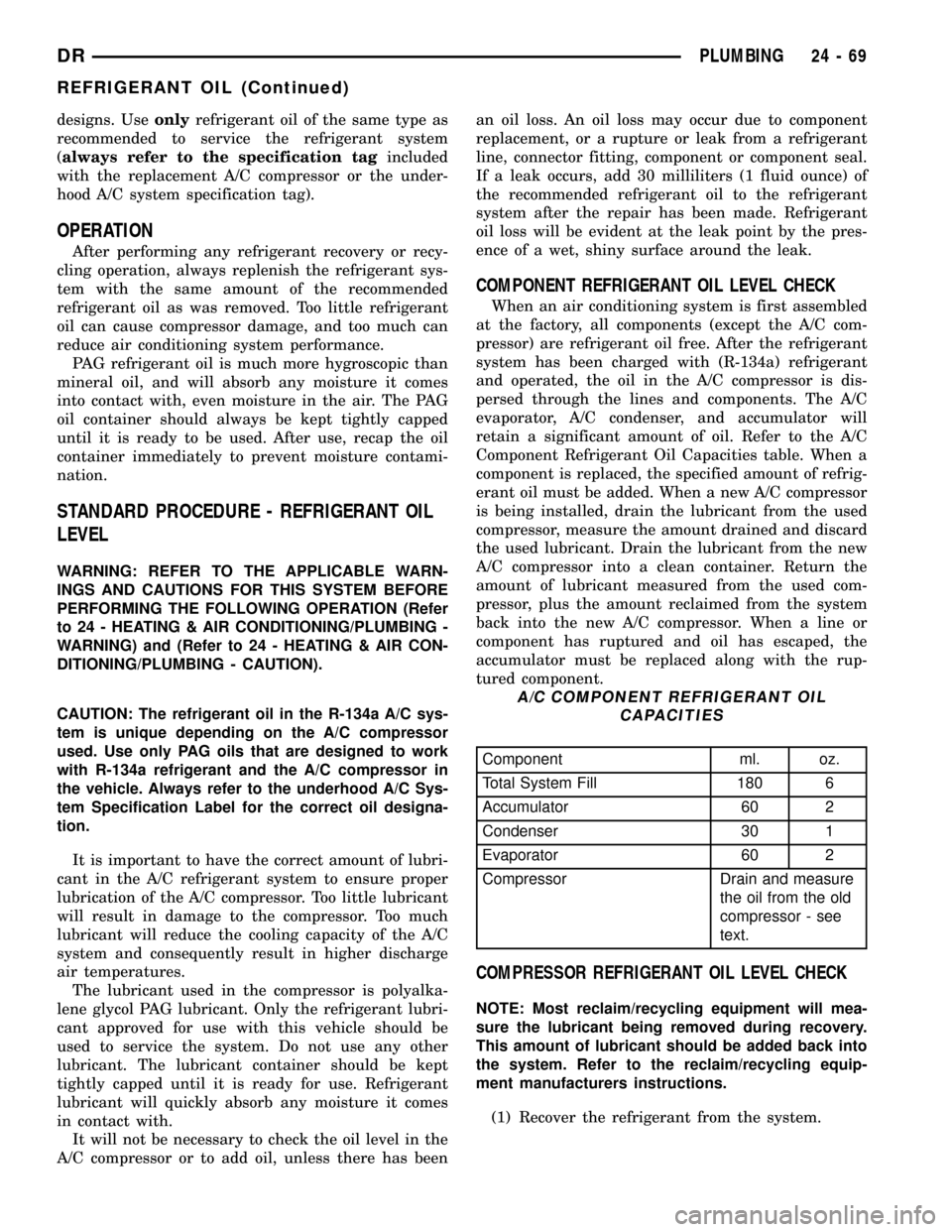IPM DODGE RAM 1500 1998 2.G Workshop Manual
[x] Cancel search | Manufacturer: DODGE, Model Year: 1998, Model line: RAM 1500, Model: DODGE RAM 1500 1998 2.GPages: 2627
Page 2531 of 2627

DIAGNOSIS AND TESTING - REFRIGERANT
SYSTEM LEAKS
WARNING: R-134a SERVICE EQUIPMENT OR VEHI-
CLE A/C SYSTEM SHOULD NOT BE PRESSURE
TESTED OR LEAK TESTED WITH COMPRESSED
AIR. MIXTURE OF AIR and R-134a CAN BE COM-
BUSTIBLE AT ELEVATED PRESSURES. THESE MIX-
TURES ARE POTENTIALLY DANGEROUS AND MAY
RESULT IN FIRE OR EXPLOSION CAUSING INJURY
OR PROPERTY DAMAGE.
AVOID BREATHING A/C REFRIGERANT AND LUBRI-
CANT VAPOR OR MIST. EXPOSURE MAY IRRITATE
EYES, NOSE AND THROAT. USE ONLY APPROVED
SERVICE EQUIPMENT MEETING SAE REQUIRE-
MENTS TO DISCHARGE R-134a SYSTEM. IF ACCI-
DENTAL SYSTEM DISCHARGE OCCURS,
VENTILATE WORK AREA BEFORE RESUMING SER-
VICE.
NOTE: The refrigerant system does come from the
factory with a yellow tracer dye already installed to
aid in detection of leaks.
If the A/C system is not cooling properly, determine
if the refrigerant system is fully charged with
R-134a. This is accomplished by performing a system
Charge Level-Check or Fill. If while performing this
test A/C liquid line pressure is less than 345 kPa (50
psi) proceed to System Empty procedure. If liquid
line pressure is greater than 345 kPa (50 psi) proceed
to System Low procedure. If the refrigerant system is
empty or low in refrigerant charge, a leak at any line
fitting or component seal is likely. A review of the fit-
tings, lines and components for oily residue is an
indication of the leak location. To detect a leak in the
refrigerant system, perform one of the following pro-
cedures as indicated by the symptoms.
SYSTEM EMPTY
(1) Evacuate the refrigerant system to the lowest
degree of vacuum possible (approx. 28 in Hg.). Deter-
mine if the system holds a vacuum for 15 minutes. If
vacuum is held, a leak is probably not present. If sys-
tem will not maintain vacuum level, proceed with
this procedure.(2) Prepare a 0.284 Kg. (10 oz.) refrigerant charge
to be injected into the system.
(3) Connect and dispense 0.284 Kg. (10 oz.) of
refrigerant into the evacuated refrigerant system.
(4) Proceed to Step 2 of System Low procedure.
SYSTEM LOW
(1) Determine if there is any (R-134a) refrigerant
in the system.
(2) Position the vehicle in a wind free work area.
This will aid in detecting small leaks.
(3) Bring the refrigerant system up to operating
temperature and pressure. This is done by allowing
the engine to run for five minutes with the system
set to the following:
²Transmission in Park or Neutral with parking
brake set
²Engine idling at 700 rpm
²A/C controls set in 100 percent outside air
²Blower switch in the high A/C position
²A/C in the ON position
²Open all windows
CAUTION: A leak detector designed for R-12 refrig-
erant (only) will not detect leaks in a R-134a refrig-
erant system.
(4) Shut off the vehicle and wait 2 to 7 minutes.
Then use an Electronic Leak Detector that is
designed to detect R-134a type refrigerant and search
for leaks. Fittings, lines, or components that appear
to be oily usually indicates a refrigerant leak. To
inspect the evaporator core for leaks, insert the leak
detector probe into the drain tube opening or a heat
duct. A R-134a dye is available to aid in leak detec-
tion, use only DaimlerChrysler approved refrigerant
dye.
24 - 44 PLUMBINGDR
PLUMBING (Continued)
Page 2533 of 2627

STANDARD PROCEDURE - REFRIGERANT
SYSTEM SERVICE EQUIPMENT
WARNING: EYE PROTECTION MUST BE WORN
WHEN SERVICING AN AIR CONDITIONING REFRIG-
ERANT SYSTEM. TURN OFF (ROTATE CLOCKWISE)
ALL VALVES ON THE EQUIPMENT BEING USED
BEFORE CONNECTING TO, OR DISCONNECTING
FROM THE REFRIGERANT SYSTEM. FAILURE TO
OBSERVE THESE WARNINGS MAY RESULT IN PER-
SONAL INJURY.
WARNING: REVIEW THE WARNINGS AND CAU-
TIONS IN THE FRONT OF THIS SECTION BEFORE
PERFORMING THE FOLLOWING OPERATION (Refer
to 24 - HEATING & AIR CONDITIONING/PLUMBING -
WARNING) and (Refer to 24 - HEATING & AIR CON-
DITIONING/PLUMBING - CAUTION).
When servicing the air conditioning system, a
R-134a refrigerant recovery/recycling/charging sta-
tion that meets SAE Standard J2210 must be used
(Fig. 2). Contact an automotive service equipment
supplier for refrigerant recovery/recycling/charging
equipment. Refer to the operating instructions sup-
plied by the equipment manufacturer for proper care
and use of this equipment.
A manifold gauge set may be needed with some
recovery/recycling/charging equipment (Fig. 3). The
service hoses on the gauge set being used should
have manual (turn wheel), or automatic back-flow
valves at the service port connector ends. This will
prevent refrigerant from being released into the
atmosphere.
MANIFOLD GAUGE SET CONNECTIONS
CAUTION: Do not use an R-12 manifold gauge set
on an R-134a system. The refrigerants are not com-
patible and system damage will result.
LOW PRESSURE GAUGE HOSE The low pressure
hose (Blue with Black stripe) attaches to the low side
service port. This service port is located on the suc-
tion line between the accumulator outlet port and the
A/C compressor.
HIGH PRESSURE GAUGE HOSE The high pres-
sure hose (Red with Black stripe) attaches to the
high side service port. This service port is located on
the discharge line near the A/C compressor. On this
model, an A/C pressure transducer is installed onto
the high pressure service port. A/C high side pres-
sures can be read using a DRBIIItscan tool. Refer to
Body Diagnostic Procedures.
RECOVERY/RECYCLING/EVACUATION/CHARG-
ING HOSE The center manifold hose (Yellow, or
White, with Black stripe) is used to recover, evacu-
ate, and charge the refrigerant system. When the low
or high pressure valves on the manifold gauge set
are opened, the refrigerant in the system will escape
through this hose.
Fig. 2 Refrigerant Recovery/Recycling Station -
Typical
1 - R-134a REFRIGERANT STATION
Fig. 3 MANIFOLD GAUGE SET - TYPICAL
1 - HIGH PRESSURE GAUGE
2 - VALVE
3 - VACUUM/REFRIGERANT HOSE (YELLOW W/ BLACK STRIPE)
4 - HIGH PRESSURE HOSE (RED W/ BLACK STRIPE)
5 - LOW PRESSURE HOSE (BLUE W/ BLACK STRIPE)
6 - VALVE
7 - LOW PRESSURE GAUGE
24 - 46 PLUMBINGDR
PLUMBING (Continued)
Page 2534 of 2627

STANDARD PROCEDURE - REFRIGERANT
RECOVERY
WARNING: REVIEW THE WARNINGS AND CAU-
TIONS IN THE FRONT OF THIS SECTION BEFORE
PERFORMING THE FOLLOWING OPERATION (Refer
to 24 - HEATING & AIR CONDITIONING/PLUMBING -
WARNING) and (Refer to 24 - HEATING & AIR CON-
DITIONING/PLUMBING - CAUTION).
A R-134a refrigerant recovery/recycling/charging
station that meets SAE Standard J2210 must be
used to recover the refrigerant from an R-134a refrig-
erant system. Refer to the operating instructions sup-
plied by the equipment manufacturer for the proper
care and use of this equipment.
STANDARD PROCEDURE - REFRIGERANT
SYSTEM EVACUATE
NOTE: Special effort must be used to prevent mois-
ture from entering the A/C system oil. Moisture in
the oil is very difficult to remove and will cause a
reliability problem with the compressor.
If a compressor designed to use R-134a refrigerant
is left open to the atmosphere for an extended period
of time. It is recommended that the refrigerant oil be
drained and replaced with new oil or a new compres-
sor be used. This will eliminate the possibility of con-
taminating the refrigerant system.
If the refrigerant system has been open to the
atmosphere, it must be evacuated before the system
can be filled. Moisture and air mixed with the refrig-
erant will raise the compressor head pressure above
acceptable operating levels. This will reduce the per-
formance of the air conditioner and damage the com-
pressor. Moisture will boil at near room temperature
when exposed to vacuum. To evacuate the refrigerant
system:
NOTE: When connecting the service equipment
coupling to the line fitting, verify that the valve of
the coupling is fully closed. This will reduce the
amount of effort required to make the connection.
(1) Recover the refrigerant system (Refer to 24 -
HEATING & AIR CONDITIONING/PLUMBING -
STANDARD PROCEDURE).
(2) Connect a suitable charging station, refrigerant
recovery machine or a manifold gauge set with vac-
uum pump and refrigerant recovery equipment.
(3) Open the suction and discharge valves and
start the vacuum pump. The vacuum pump should
run a minimum of 45 minutes prior to charge to
eliminate all moisture in system. When the suction
gauge reads -88 kPa (- 26 in. Hg) vacuum or greaterfor 30 minutes, close all valves and turn off vacuum
pump. If the system fails to reach specified vacuum,
the refrigerant system likely has a leak that must be
corrected. If the refrigerant system maintains speci-
fied vacuum for at least 30 minutes, start the vac-
uum pump, open the suction and discharge valves.
Then allow the system to evacuate an additional 10
minutes.
(4) Close all valves. Turn off and disconnect the
vacuum pump.
(5) Charge the refrigerant system (Refer to 24 -
HEATING & AIR CONDITIONING/PLUMBING -
STANDARD PROCEDURE).
STANDARD PROCEDURE - REFRIGERANT
SYSTEM CHARGE
WARNING: REVIEW SAFETY PRECAUTIONS AND
WARNINGS IN THIS GROUP BEFORE CHARGING
THE REFRIGERANT SYSTEM.
AVOID BREATHING A/C REFRIGERANT AND LUBRI-
CANT VAPOR OR MIST. EXPOSURE MAY IRRITATE
EYES, NOSE AND THROAT. USE ONLY APPROVED
SERVICE EQUIPMENT MEETING SAE REQUIRE-
MENTS TO DISCHARGE R-134a SYSTEM. IF ACCI-
DENTAL SYSTEM DISCHARGE OCCURS,
VENTILATE WORK AREA BEFORE RESUMING SER-
VICE.
R-134a SERVICE EQUIPMENT OR VEHICLE A/C
SYSTEM SHOULD NOT BE PRESSURE TESTED OR
LEAK TESTED WITH COMPRESSED AIR. MIXTURE
OF AIR and R-134a CAN BE COMBUSTIBLE AT ELE-
VATED PRESSURES. THESE MIXTURES ARE
POTENTIALLY DANGEROUS AND MAY RESULT IN
FIRE OR EXPLOSION CAUSING INJURY OR PROP-
ERTY DAMAGE.
CAUTION: Do not overcharge refrigerant system, as
excessive compressor head pressure can cause
noise and system failure.
CAUTION: A small amount of refrigerant oil is
removed from the A/C system each time the refrig-
erant system is recovered and evacuated. Before
charging the A/C system, you MUST replenish any
oil lost during the recovery process. Refer the
equipment manufacturer instructions for more infor-
mation.
The procedure below should be used to fill the
refrigerant charge in the air conditioning system.
This A/C system does not have or use a sight glass to
check or charge the system.
DRPLUMBING 24 - 47
PLUMBING (Continued)
Page 2535 of 2627

After the system has been tested for leaks and
evacuated, a refrigerant (R-134a) charge can be
injected into the system.
NOTE: When connecting the service equipment
coupling to the line fitting, verify that the valve of
the coupling is fully closed. This will reduce the
amount of effort required to make the connection.
(1) If using a separate vacuum pump close all
valves before disconnecting pump. Connect manifold
gauge set to the A/C service ports.
NOTE: Always refer to the underhood HVAC Speci-
fication label for the refrigerant fill level of the vehi-
cle being serviced.
(2) Measure refrigerant (refer to capacities). Refer
to the instructions provided with the equipment
being used.
(3) Verify engine is shut off. Open the suction and
discharge valves. Open the charge valve to allow the
refrigerant to flow into the system. When the trans-
fer of refrigerant has stopped, close the suction and
discharge valve.
(4) If all of the charge did not transfer from the
dispensing device, put vehicle controls into the fol-
lowing mode:
²Automatic transmission in park or manual
transmission in neutral
²Engine at idle
²A/C mode control set to outside air
²A/C mode control set to panel mode
²A/C temperature control set to full cool
²Blower motor control set on highest speed
²Vehicle windows closed
If the A/C compressor does not engage, test the
compressor clutch control circuit and correct any fail-
ure (Refer to 8 - ELECTRICAL/WIRING DIAGRAM
INFORMATION - DIAGNOSIS AND TESTING).
(5) Open the suction valve to allow the remaining
refrigerant to transfer to the system.
WARNING: TAKE CARE NOT TO OPEN THE DIS-
CHARGE (HIGH-PRESSURE) VALVE AT THIS TIME.
(6) Close all valves and test the A/C system perfor-
mance.
(7) Disconnect the charging station or manifold
gauge set. Install the service port caps.
REFRIGERANT CHARGE CAPACITY
The R-134a refrigerant system charge capacity for
this vehicle can be found on the underhood HVAC
specfication tag.
A/C COMPRESSOR
DESCRIPTION
DESCRIPTION - A/C COMPRESSOR
The A/C system on models equipped with the 5.9L
engine use a Sanden SD-7 reciprocating swash plate-
type compressor. This compressor has a fixed dis-
placement of 165 cubic centimeter (10.068 cubic
inches) and has both the suction and discharge ports
located on the cylinder head.
The A/C system on models equipped with the 3.7L,
4.7L and 5.7L engines use a Denso 10S17 reciprocat-
ing swash plate-type compressor. This compressor
has a fixed displacement of 170 cubic centimeter and
has both the suction and discharge ports located on
the cylinder head.
A label identifying the use of R-134a refrigerant is
located on both A/C compressors.
DESCRIPTION - HIGH PRESSURE RELIEF
VALVE
A high pressure relief valve is located on the com-
pressor cylinder head, which is on the rear of the
compressor. This mechanical valve is designed to
vent refrigerant from the system to protect against
damage to the compressor and other system compo-
nents, caused by condenser air flow restriction or an
overcharge of refrigerant.
OPERATION
OPERATION - A/C COMPRESSOR
The A/C compressor is driven by the engine
through an electric clutch, drive pulley and belt
arrangement. The compressor is lubricated by refrig-
erant oil that is circulated throughout the refrigerant
system with the refrigerant.
The compressor draws in low-pressure refrigerant
vapor from the evaporator through its suction port. It
then compresses the refrigerant into a high-pressure,
high-temperature refrigerant vapor, which is then
pumped to the condenser through the compressor dis-
charge port.
The compressor cannot be repaired. If faulty or
damaged, the entire compressor assembly must be
replaced. The compressor clutch, pulley and clutch
coil are available for service.
OPERATION - HIGH PRESSURE RELIEF VALVE
The high pressure relief valve vents the system
when a discharge pressure of 3445 to 4135 kPa (500
to 600 psi) or above is reached. The valve closes
24 - 48 PLUMBINGDR
PLUMBING (Continued)
Page 2556 of 2627

designs. Useonlyrefrigerant oil of the same type as
recommended to service the refrigerant system
(always refer to the specification tagincluded
with the replacement A/C compressor or the under-
hood A/C system specification tag).
OPERATION
After performing any refrigerant recovery or recy-
cling operation, always replenish the refrigerant sys-
tem with the same amount of the recommended
refrigerant oil as was removed. Too little refrigerant
oil can cause compressor damage, and too much can
reduce air conditioning system performance.
PAG refrigerant oil is much more hygroscopic than
mineral oil, and will absorb any moisture it comes
into contact with, even moisture in the air. The PAG
oil container should always be kept tightly capped
until it is ready to be used. After use, recap the oil
container immediately to prevent moisture contami-
nation.
STANDARD PROCEDURE - REFRIGERANT OIL
LEVEL
WARNING: REFER TO THE APPLICABLE WARN-
INGS AND CAUTIONS FOR THIS SYSTEM BEFORE
PERFORMING THE FOLLOWING OPERATION (Refer
to 24 - HEATING & AIR CONDITIONING/PLUMBING -
WARNING) and (Refer to 24 - HEATING & AIR CON-
DITIONING/PLUMBING - CAUTION).
CAUTION: The refrigerant oil in the R-134a A/C sys-
tem is unique depending on the A/C compressor
used. Use only PAG oils that are designed to work
with R-134a refrigerant and the A/C compressor in
the vehicle. Always refer to the underhood A/C Sys-
tem Specification Label for the correct oil designa-
tion.
It is important to have the correct amount of lubri-
cant in the A/C refrigerant system to ensure proper
lubrication of the A/C compressor. Too little lubricant
will result in damage to the compressor. Too much
lubricant will reduce the cooling capacity of the A/C
system and consequently result in higher discharge
air temperatures.
The lubricant used in the compressor is polyalka-
lene glycol PAG lubricant. Only the refrigerant lubri-
cant approved for use with this vehicle should be
used to service the system. Do not use any other
lubricant. The lubricant container should be kept
tightly capped until it is ready for use. Refrigerant
lubricant will quickly absorb any moisture it comes
in contact with.
It will not be necessary to check the oil level in the
A/C compressor or to add oil, unless there has beenan oil loss. An oil loss may occur due to component
replacement, or a rupture or leak from a refrigerant
line, connector fitting, component or component seal.
If a leak occurs, add 30 milliliters (1 fluid ounce) of
the recommended refrigerant oil to the refrigerant
system after the repair has been made. Refrigerant
oil loss will be evident at the leak point by the pres-
ence of a wet, shiny surface around the leak.
COMPONENT REFRIGERANT OIL LEVEL CHECK
When an air conditioning system is first assembled
at the factory, all components (except the A/C com-
pressor) are refrigerant oil free. After the refrigerant
system has been charged with (R-134a) refrigerant
and operated, the oil in the A/C compressor is dis-
persed through the lines and components. The A/C
evaporator, A/C condenser, and accumulator will
retain a significant amount of oil. Refer to the A/C
Component Refrigerant Oil Capacities table. When a
component is replaced, the specified amount of refrig-
erant oil must be added. When a new A/C compressor
is being installed, drain the lubricant from the used
compressor, measure the amount drained and discard
the used lubricant. Drain the lubricant from the new
A/C compressor into a clean container. Return the
amount of lubricant measured from the used com-
pressor, plus the amount reclaimed from the system
back into the new A/C compressor. When a line or
component has ruptured and oil has escaped, the
accumulator must be replaced along with the rup-
tured component.
A/C COMPONENT REFRIGERANT OIL
CAPACITIES
Component ml. oz.
Total System Fill 180 6
Accumulator 60 2
Condenser 30 1
Evaporator 60 2
Compressor Drain and measure
the oil from the old
compressor - see
text.
COMPRESSOR REFRIGERANT OIL LEVEL CHECK
NOTE: Most reclaim/recycling equipment will mea-
sure the lubricant being removed during recovery.
This amount of lubricant should be added back into
the system. Refer to the reclaim/recycling equip-
ment manufacturers instructions.
(1) Recover the refrigerant from the system.
DRPLUMBING 24 - 69
REFRIGERANT OIL (Continued)
Page 2599 of 2627

ENGINE COOLANT TEMPERATURE
SENSOR - REMOVAL...................7-39
ENGINE COOLANT THERMOSTAT -
3.7L/4.7L - DESCRIPTION...............7-44
ENGINE COOLANT THERMOSTAT -
3.7L/4.7L - INSTALLATION..............7-45
ENGINE COOLANT THERMOSTAT -
3.7L/4.7L - OPERATION.................7-44
ENGINE COOLANT THERMOSTAT -
3.7L/4.7L - REMOVAL..................7-45
ENGINE COOLANT THERMOSTAT - 5.9L
DIESEL - DESCRIPTION................7-46
ENGINE COOLANT THERMOSTAT - 5.9L
DIESEL - INSTALLATION................7-47
ENGINE COOLANT THERMOSTAT - 5.9L
DIESEL - OPERATION..................7-46
ENGINE COOLANT THERMOSTAT - 5.9L
DIESEL - REMOVAL....................7-47
ENGINE COOLANT THERMOSTAT - 8.0L -
DESCRIPTION........................7-48
ENGINE COOLANT THERMOSTAT - 8.0L -
INSTALLATION........................7-49
ENGINE COOLANT THERMOSTAT - 8.0L -
OPERATION..........................7-48
ENGINE COOLANT THERMOSTAT - 8.0L -
REMOVAL...........................7-49
ENGINE COOLANT THERMOSTAT-5.7L -
DESCRIPTION........................7-41
ENGINE COOLANT THERMOSTAT-5.7L -
INSTALLATION........................7-43
ENGINE COOLANT THERMOSTAT-5.7L -
OPERATION..........................7-41
ENGINE COOLANT THERMOSTAT-5.7L -
REMOVAL.............................7-42
ENGINE COOLING SYSTEM
REQUIREMENTS - DESCRIPTION.........24-1
ENGINE COOLING SYSTEM, WARNING....24-42
ENGINE DATA PLATE - DESCRIPTION.....9-248
ENGINE DIAGNOSIS - INTRODUCTION -
DIAGNOSIS AND TESTING......9-183,9-4,9-94
ENGINE DIAGNOSIS - LUBRICATION -
DIAGNOSIS AND TESTING..........9-187,9-7
ENGINE DIAGNOSIS - MECHANICAL -
DIAGNOSIS AND TESTING . . . 9-185,9-188,9-233,
9-6,9-92
ENGINE DIAGNOSIS - PERFORMANCE -
DIAGNOSIS AND TESTING......9-183,9-4,9-90
ENGINE FIRING ORDER, 3.7L V-6.........8I-4
ENGINE FIRING ORDER, 4.7L V-8.........8I-4
ENGINE GASKET SURFACE
PREPARATION - STANDARD
PROCEDURE.........................9-10
ENGINE OIL - DIESEL ENGINES -
DESCRIPTION.........................0-2
ENGINE OIL AND LUBRICANTS -
DESCRIPTION.........................0-1
ENGINE OIL LEAK - DIAGNOSIS AND
TESTING..................9-152,9-220,9-64
ENGINE OIL LEVEL - STANDARD
PROCEDURE........................9-292
ENGINE OIL PRESSURE - DIAGNOSIS
AND TESTING.......................9-289
ENGINE OIL PRESSURE - DIAGNOSIS
AND TESTING, CHECKING.....9-152,9-220,9-65
ENGINE OIL SERVICE - STANDARD
PROCEDURE..........9-153,9-222,9-292,9-71
ENGINE, SPECIAL TOOLS - 4.7L.........9-103
ENGINE, SPECIAL TOOLS - 5.7L.........9-196
ENGINE, SPECIAL TOOLS - 5.9L DIESEL . . 9-246
ENGINE, SPECIFICATIONS - 5.7L........9-192
ENGINE TEMPERATURE GAUGE -
DESCRIPTION.......................8J-24
ENGINE TEMPERATURE GAUGE -
OPERATION.........................8J-24
ENGINE TIMING - VERIFICATION -
STANDARD PROCEDURE...............9-167
ENGINES - CLEANING, RADIATOR FAN -
GAS................................7-34
ENGINES - DESCRIPTION, COOLANT
RECOVERY CONTAINER- GAS
............7-33
ENGINES - DESCRIPTION, ENGINE OIL -
DIESEL
..............................0-2
ENGINES - DESCRIPTION, FAN DRIVE
VISCOUS CLUTCH-GAS
.................7-50
ENGINES - INSPECTION, RADIATOR FAN
- GAS
...............................7-34
ENGINES - INSTALLATION, 3.7, 4.7 AND
5.7L
..........................24-53,24-55ENGINES - INSTALLATION, COOLANT
RECOVERY CONTAINER- GAS............7-33
ENGINES - INSTALLATION, RADIATOR
FAN - GAS...........................7-34
ENGINES - OPERATION, COOLANT
RECOVERY CONTAINER- GAS............7-33
ENGINES - OPERATION, FAN DRIVE
VISCOUS CLUTCH-GAS.................7-50
ENGINES - REMOVAL, 3.7, 4.7 AND 5.7L . 24-52,
24-55
ENGINES - REMOVAL, COOLANT
RECOVERY CONTAINER- GAS............7-33
ENGINES - REMOVAL, RADIATOR FAN -
GAS................................7-33
ENGINES - STANDARD PROCEDURE,
DRAINING COOLING SYSTEM - ALL
GAS................................7-17
ENGINES - STANDARD PROCEDURE,
REFILLING COOLING SYSTEM - ALL
GAS................................7-18
ENHANCED SEATBELT REMINDER
PROGRAMMING - STANDARD
PROCEDURE........................8J-35
ENTRY MODULE - DESCRIPTION,
REMOTE KEYLESS....................8N-7
ENTRY MODULE - DIAGNOSIS AND
TESTING, REMOTE KEYLESS............8N-7
ENTRY MODULE - INSTALLATION,
REMOTE KEYLESS....................8N-8
ENTRY MODULE - OPERATION, REMOTE
KEYLESS............................8N-7
ENTRY MODULE - REMOVAL, REMOTE
KEYLESS............................8N-7
ENTRY TRANSMITTER - DIAGNOSIS AND
TESTING, REMOTE KEYLESS..............8N-8
ENTRY TRANSMITTER -
SPECIFICATIONS, REMOTE KEYLESS......8N-9
EQUIPMENT - STANDARD PROCEDURE,
REFRIGERANT SYSTEM SERVICE........24-46
ERASING TRANSMITTER CODES -
STANDARD PROCEDURE..............8M-12
ETC INDICATOR - DESCRIPTION.........8J-25
ETC INDICATOR - OPERATION..........8J-25
EVACUATE - STANDARD PROCEDURE,
REFRIGERANT SYSTEM...............24-47
EVAP SYSTEM - DESCRIPTION..........25-10
EVAP SYSTEM - TORQUE..............25-11
EVAPORATOR - DESCRIPTION, A/C.......24-59
EVAPORATOR - INSTALLATION, A/C......24-60
EVAPORATOR - OPERATION, A/C........24-59
EVAPORATOR - REMOVAL, A/C..........24-60
EVAPORATOR TEMPERATURE SENSOR -
DESCRIPTION.......................24-22
EVAPORATOR TEMPERATURE SENSOR -
INSTALLATION.......................24-22
EVAPORATOR TEMPERATURE SENSOR -
OPERATION.........................24-22
EVAPORATOR TEMPERATURE SENSOR -
REMOVAL..........................24-22
EVAP/PURGE SOLENOID - DESCRIPTION . . 25-12
EVAP/PURGE SOLENOID - INSTALLATION . 25-12
EVAP/PURGE SOLENOID - OPERATION....25-12
EVAP/PURGE SOLENOID - REMOVAL.....25-12
EXHAUST MANIFOLD - CLEANING . . 9-163,9-226,
9-298
EXHAUST MANIFOLD - DESCRIPTION....9-161,
9-226,9-74
EXHAUST MANIFOLD - INSPECTION.....9-163,
9-227,9-298
EXHAUST MANIFOLD - INSTALLATION . . . 9-164,
9-227,9-298,9-74
EXHAUST MANIFOLD - OPERATION......9-226
EXHAUST MANIFOLD - REMOVAL . . 9-161,9-226,
9-298,9-74
EXHAUST PIPE - INSPECTION.......11-7,11-8
EXTENSION HOUSING BUSHING AND
SEAL - INSTALLATION................21-440
EXTENSION HOUSING BUSHING AND
SEAL - REMOVAL
...................21-440
EXTENSION HOUSING SEAL -
INSTALLATION
. . . 21-128,21-201,21-507,21-536,
21-85
EXTENSION HOUSING SEAL - REMOVAL
. 21-128,
21-201,21-507,21-536,21-85
EXTENSION HOUSING SEAL AND DUST
BOOT - INSTALLATION
.........21-476,21-571
EXTENSION HOUSING SEAL AND DUST
BOOT - REMOVAL
.............21-476,21-571EXTERIOR - DESCRIPTION, LAMPS/
LIGHTING...........................8L-2
EXTERIOR - DIAGNOSIS AND TESTING,
LAMPS/LIGHTING.....................8L-3
EXTERIOR - OPERATION, LAMPS/
LIGHTING...........................8L-2
EXTERIOR HANDLE - INSTALLATION.....23-21,
23-30
EXTERIOR HANDLE - REMOVAL....23-20,23-30
EXTERIOR LAMPS, SPECIFICATIONS......8L-7
EXTERIOR NAME PLATES -
INSTALLATION.......................23-38
EXTERIOR NAME PLATES - REMOVAL....23-38
FAILURE - DIAGNOSIS AND TESTING,
CYLINDER HEAD GASKET..............9-199
FAN - 5.9L DIESEL - CLEANING,
RADIATOR...........................7-35
FAN - 5.9L DIESEL - INSPECTION,
RADIATOR...........................7-35
FAN - 5.9L DIESEL - INSTALLATION,
RADIATOR...........................7-36
FAN - 5.9L DIESEL - REMOVAL,
RADIATOR...........................7-35
FAN - GAS ENGINES - CLEANING,
RADIATOR...........................7-34
FAN - GAS ENGINES - INSPECTION,
RADIATOR...........................7-34
FAN - GAS ENGINES - INSTALLATION,
RADIATOR...........................7-34
FAN - GAS ENGINES - REMOVAL,
RADIATOR...........................7-33
FAN DRIVE - DIAGNOSIS AND TESTING,
ELECTRONICALLY CONTROLLED
VISCOUS............................7-52
FAN DRIVE - DIAGNOSIS AND TESTING,
VISCOUS............................7-50
FAN DRIVE VISCOUS CLUTCH - 5.9L
DIESEL - DESCRIPTION................7-52
FAN DRIVE VISCOUS CLUTCH - 5.9L
DIESEL - OPERATION..................7-52
FAN DRIVE VISCOUS CLUTCH-GAS
ENGINES - DESCRIPTION...............7-50
FAN DRIVE VISCOUS CLUTCH-GAS
ENGINES - OPERATION.................7-50
FASCIA - INSTALLATION, FRONT.........13-3
FASCIA - REMOVAL, FRONT.............13-2
FASTENER IDENTIFICATION -
DESCRIPTION......................Intro.-5
FASTENER USAGE - DESCRIPTION......Intro.-8
FENDER - INSTALLATION, FRONT........23-39
FENDER - INSTALLATION, REAR.........23-44
FENDER - REMOVAL, FRONT...........23-39
FENDER - REMOVAL, REAR............23-44
FENDER MARKER LAMP - INSTALLATION . 8L-18
FENDER MARKER LAMP - REMOVAL.....8L-17
FENDER RAIL REPAIR - STANDARD
PROCEDURE, HYDROFORM............13-11
FILL - STANDARD PROCEDURE,
TRANSMISSION...............21-204,21-368
FILL DOOR - INSTALLATION, FUEL.......23-39
FILL DOOR - REMOVAL, FUEL..........23-39
FILLER CAP - DESCRIPTION, FUEL.......25-13
FILLER CAP - OPERATION, FUEL........25-13
FILTER - INSTALLATION, INLET..........14-20
FILTER - INSTALLATION, OIL . 9-155,9-223,9-293,
9-70
FILTER - REMOVAL, INLET.............14-20
FILTER - REMOVAL, OIL . 9-154,9-223,9-293,9-70
FILTER - STANDARD PROCEDURES,
WATER DRAINING AT FUEL............14-47
FILTER / WATER SEPARATOR -
DESCRIPTION, FUEL..................14-50
FILTER / WATER SEPARATOR -
INSTALLATION, FUEL.................14-50
FILTER / WATER SEPARATOR -
OPERATION, FUEL....................14-50
FILTER / WATER SEPARATOR -
REMOVAL, FUEL.....................14-50
FILTER REPLACEMENT - STANDARD
PROCEDURE, FLUID
...........21-203,21-367
FILTER/PRESSURE REGULATOR -
DESCRIPTION, FUEL
...................14-5
FILTER/PRESSURE REGULATOR -
OPERATION, FUEL
.....................14-6
FINESSE SANDING/BUFFING &
POLISHING - DESCRIPTION
............23-74
FINISH - DESCRIPTION, BASECOAT/
CLEARCOAT
.........................23-73
12 INDEXDR
Description Group-Page Description Group-Page Description Group-Page
Page 2613 of 2627

RAIL - DESCRIPTION, FUEL INJECTOR....14-78
RAIL - INSTALLATION, FUEL............14-15
RAIL - INSTALLATION, FUEL INJECTOR . . . 14-78
RAIL - OPERATION, FUEL..............14-12
RAIL - OPERATION, FUEL INJECTOR.....14-78
RAIL - REMOVAL, FUEL...............14-13
RAIL - REMOVAL, FUEL INJECTOR.......14-78
RAIL REPAIR - STANDARD PROCEDURE,
HYDROFORM FENDER.................13-11
RAIL TIP REPLACEMENT - STANDARD
PROCEDURE, LIGHT DUTY FRONT
FRAME..............................13-4
RAIL WEATHERSTRIP - INSTALLATION,
DRIP..............................23-91
RAIL WEATHERSTRIP - REMOVAL, DRIP . . 23-91
RAIL WEATHERSTRIP RETAINER -
INSTALLATION, DRIP.................23-92
RAIL WEATHERSTRIP RETAINER -
REMOVAL, DRIP.....................23-92
RANGE SENSOR - DESCRIPTION,
TRANSMISSION...............21-263,21-405
RANGE SENSOR - INSTALLATION,
TRANSMISSION.....................21-266
RANGE SENSOR - OPERATION,
TRANSMISSION...............21-263,21-405
RANGE SENSOR - REMOVAL,
TRANSMISSION.....................21-265
RANGE SENSOR (TRS) - DIAGNOSIS
AND TESTING, TRANSMISSION........21-264
RATINGS, SPECIFICATIONS -
GENERATOR........................8F-20
RE TRANSMISSION, SPECIAL TOOLS....21-191
READING LAMP - DESCRIPTION.........8L-28
READING LAMP - INSTALLATION........8L-29
READING LAMP - OPERATION..........8L-28
READING LAMP - REMOVAL............8L-28
READING/COURTESY LAMP
REPLACEMENT - STANDARD
PROCEDURE.........................8M-3
REAR AXLE - 10 1/2 AA -
ADJUSTMENTS......................3-116
REAR AXLE - 10 1/2 AA - DIAGNOSIS
AND TESTING.......................3-112
REAR AXLE - 10 1/2 AA - INSTALLATION . . 3-116
REAR AXLE - 10 1/2 AA - REMOVAL.....3-115
REAR AXLE - 10 1/2 AA - SPECIAL
TOOLS.............................3-120
REAR AXLE - 10 1/2 AA -
SPECIFICATIONS.....................3-120
REAR AXLE - 11 1/2 AA -
ADJUSTMENTS......................3-144
REAR AXLE - 11 1/2 AA - DIAGNOSIS
AND TESTING.......................3-140
REAR AXLE - 11 1/2 AA - INSTALLATION . . 3-144
REAR AXLE - 11 1/2 AA - REMOVAL.....3-143
REAR AXLE - 11 1/2 AA - SPECIAL
TOOLS.............................3-148
REAR AXLE - 11 1/2 AA -
SPECIFICATIONS.....................3-148
REAR AXLE - 9 1/4 - ADJUSTMENTS......3-83
REAR AXLE - 9 1/4 - DIAGNOSIS AND
TESTING............................3-80
REAR AXLE - 9 1/4 - INSTALLATION......3-83
REAR AXLE - 9 1/4 - REMOVAL..........3-83
REAR AXLE - 9 1/4 - SPECIAL TOOLS.....3-90
REAR AXLE - 9 1/4 - SPECIFICATIONS.....3-90
REAR BEARING - INSTALLATION,
OUTPUT SHAFT.....................21-217
REAR BEARING - REMOVAL, OUTPUT
SHAFT............................21-216
REAR BRAKE HOSE - INSTALLATION......5-12
REAR BRAKE HOSE - REMOVAL..........5-11
REAR BUMPER - INSTALLATION..........13-4
REAR BUMPER - REMOVAL.............13-3
REAR CAB BACK PANEL TRIM -
INSTALLATION.......................23-69
REAR CAB BACK PANEL TRIM -
REMOVAL..........................23-68
REAR CABLE - INSTALLATION, LEFT......5-39
REAR CABLE - INSTALLATION, RIGHT.....5-38
REAR CABLE - REMOVAL, LEFT..........5-38
REAR CABLE - REMOVAL, RIGHT
.........5-37
REAR CENTER SEAT BELT &
RETRACTOR - INSTALLATION
...........8O-45
REAR CENTER SEAT BELT &
RETRACTOR - REMOVAL
..............8O-44
REAR CLUTCH - ASSEMBLY
...........21-249
REAR CLUTCH - CLEANING
...........21-248REAR CLUTCH - DESCRIPTION.........21-247
REAR CLUTCH - DISASSEMBLY........21-248
REAR CLUTCH - INSPECTION..........21-248
REAR CLUTCH - OPERATION..........21-248
REAR DOOR GLASS RUN
WEATHERSTRIP - INSTALLATION........23-93
REAR DOOR GLASS RUN
WEATHERSTRIP - REMOVAL............23-93
REAR DOOR INNER BELT MOLDING -
INSTALLATION.......................23-94
REAR DOOR INNER BELT MOLDING -
REMOVAL..........................23-94
REAR DOOR OUTER BELT MOLDING -
INSTALLATION.......................23-94
REAR DOOR OUTER BELT MOLDING -
REMOVAL..........................23-93
REAR DOOR SILL TRIM COVER -
INSTALLATION.......................23-71
REAR DOOR SILL TRIM COVER -
REMOVAL..........................23-71
REAR DRUM IN HAT BRAKE - CLEANING . . . 5-39
REAR DRUM IN HAT BRAKE -
INSPECTION.........................5-39
REAR DUAL WHEELS - INSTALLATION.....5-35
REAR DUAL WHEELS - REMOVAL........5-34
REAR FENDER - INSTALLATION.........23-44
REAR FENDER - REMOVAL.............23-44
REAR FRAME H-SECTION REPLACEMENT
- STANDARD PROCEDURE.............13-13
REAR MOUNT - INSTALLATION....9-149,9-220,
9-288,9-61
REAR MOUNT - REMOVAL . . . 9-149,9-220,9-288,
9-61
REAR OIL SEAL RETAINER -
INSTALLATION, CRANKSHAFT......9-210,9-277
REAR OIL SEAL RETAINER - REMOVAL,
CRANKSHAFT..................9-209,9-277
REAR OUTBOARD SEAT BELT &
RETRACTOR - INSTALLATION...........8O-47
REAR OUTBOARD SEAT BELT &
RETRACTOR - REMOVAL..............8O-46
REAR PARK BRAKE CABLE -
INSTALLATION........................5-38
REAR PARK BRAKE CABLE - REMOVAL....5-37
REAR PROPELLER SHAFT -
INSTALLATION.........................3-8
REAR PROPELLER SHAFT - REMOVAL......3-8
REAR SEAL AREA LEAKS - DIAGNOSIS
AND TESTING..............9-137,9-209,9-65
REAR SERVO - ASSEMBLY............21-251
REAR SERVO - CLEANING............21-251
REAR SERVO - DESCRIPTION..........21-251
REAR SERVO - DISASSEMBLY.........21-251
REAR SERVO - OPERATION...........21-251
REAR TUBE / HOSE ASSEMBLY -
INSTALLATION........................5-13
REAR TUBE / HOSE ASSEMBLY -
REMOVAL...........................5-12
REAR VIEW MIRROR - REMOVAL........23-69
REAR VIEW MIRROR SUPPORT
BRACKET - INSTALLATION.............23-70
REAR WHEEL ANTILOCK - DIAGNOSIS
AND TESTING
........................5-48
REAR WHEEL INSTALLATION -
STANDARD PROCEDURE, DUAL
.........22-12
REAR WHEEL SPEED SENSOR -
DIAGNOSIS AND TESTING
..............5-49
REAR WHEEL SPEED SENSOR -
INSTALLATION
........................5-48
REAR WHEEL SPEED SENSOR -
REMOVAL
...........................5-48
REAR WHEELHOUSE SPLASH SHIELD -
INSTALLATION
.......................23-41
REAR WHEELHOUSE SPLASH SHIELD -
REMOVAL
..........................23-41
REAR WINDOW DEFOGGER RELAY -
DESCRIPTION
........................8G-2
REAR WINDOW DEFOGGER RELAY -
INSTALLATION
.......................8G-4
REAR WINDOW DEFOGGER RELAY -
OPERATION
..........................8G-3
REAR WINDOW DEFOGGER RELAY -
REMOVAL
...........................8G-3
REAR WINDOW DEFOGGER SWITCH -
DESCRIPTION
........................8G-4
REAR WINDOW DEFOGGER SWITCH -
OPERATION
..........................8G-4REAR WINDOW DEFOGGER SYSTEM -
DIAGNOSIS AND TESTING..............8G-2
RECEIVER - INSTALLATION, ASH........23-51
RECEIVER - REMOVAL, ASH............23-50
RECIRCULATION DOOR - INSTALLATION . . 24-40
RECIRCULATION DOOR - REMOVAL......24-39
RECIRCULATION DOOR ACTUATOR -
DESCRIPTION.......................24-24
RECIRCULATION DOOR ACTUATOR -
INSTALLATION.......................24-25
RECIRCULATION DOOR ACTUATOR -
OPERATION.........................24-24
RECIRCULATION DOOR ACTUATOR -
REMOVAL..........................24-24
RECOVERY - STANDARD PROCEDURE,
REFRIGERANT.......................24-47
RECOVERY CONTAINER- GAS ENGINES -
DESCRIPTION, COOLANT...............7-33
RECOVERY CONTAINER- GAS ENGINES -
INSTALLATION, COOLANT...............7-33
RECOVERY CONTAINER- GAS ENGINES -
OPERATION, COOLANT.................7-33
RECOVERY CONTAINER- GAS ENGINES -
REMOVAL, COOLANT..................7-33
REDUCER - DESCRIPTION, SEAT BELT
TENSION...........................8O-53
REDUCER - DIAGNOSIS AND TESTING,
SEAT BELT TENSION..................8O-54
REDUCER - OPERATION, SEAT BELT
TENSION...........................8O-54
REFACING - STANDARD PROCEDURE . 9-202,9-28
REFACING - STANDARD PROCEDURE,
CYLINDER BLOCK....................9-264
REFILLING COOLING SYSTEM - ALL GAS
ENGINES - STANDARD PROCEDURE......7-18
REFILLING COOLING SYSTEM 5.9L
DIESEL ENGINE - STANDARD
PROCEDURE.........................7-19
REFRIGERANT - DESCRIPTION..........24-67
REFRIGERANT - OPERATION............24-67
REFRIGERANT LINE - DESCRIPTION......24-42
REFRIGERANT LINE COUPLER -
DESCRIPTION.......................24-67
REFRIGERANT LINE COUPLER -
INSTALLATION.......................24-68
REFRIGERANT LINE COUPLER -
OPERATION.........................24-67
REFRIGERANT LINE COUPLER -
REMOVAL..........................24-68
REFRIGERANT LINES - OPERATION......24-42
REFRIGERANT OIL - DESCRIPTION......24-68
REFRIGERANT OIL - OPERATION........24-69
REFRIGERANT OIL LEVEL - STANDARD
PROCEDURE........................24-69
REFRIGERANT RECOVERY - STANDARD
PROCEDURE........................24-47
REFRIGERANT SYSTEM CHARGE -
STANDARD PROCEDURE...............24-47
REFRIGERANT SYSTEM EVACUATE -
STANDARD PROCEDURE...............24-47
REFRIGERANT SYSTEM LEAKS -
DIAGNOSIS AND TESTING.............24-44
REFRIGERANT SYSTEM SERVICE
EQUIPMENT - STANDARD PROCEDURE . . . 24-46
REGULATOR - DESCRIPTION, FUEL
FILTER/PRESSURE.....................14-5
REGULATOR - DESCRIPTION, VOLTAGE . . . 8F-25
REGULATOR - MANUAL - INSTALLATION,
WINDOW......................23-27,23-35
REGULATOR - MANUAL - REMOVAL,
WINDOW......................23-26,23-35
REGULATOR - OPERATION, FUEL
FILTER/PRESSURE.....................14-6
REGULATOR - OPERATION, VOLTAGE.....8F-25
REGULATOR - POWER - INSTALLATION,
WINDOW......................23-26,23-34
REGULATOR - POWER - REMOVAL,
WINDOW......................23-25,23-34
RELAY - DESCRIPTION, A/C
COMPRESSOR CLUTCH...............24-13
RELAY - DESCRIPTION, FOG LAMP......8L-12
RELAY - DESCRIPTION, FUEL HEATER
....14-52
RELAY - DESCRIPTION, FUEL PUMP
.....14-27
RELAY - DESCRIPTION, INTAKE AIR
HEATER
............................14-82
RELAY - DESCRIPTION, PARK LAMP
.....8L-20
RELAY - DESCRIPTION, REAR WINDOW
DEFOGGER
..........................8G-2
26 INDEXDR
Description Group-Page Description Group-Page Description Group-Page